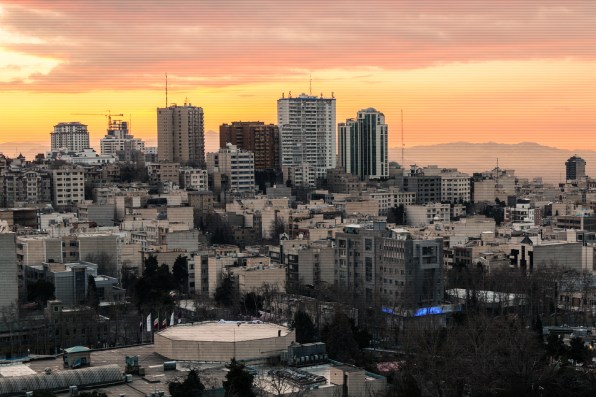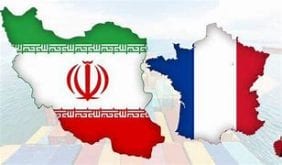fastcompany-For exiles who want to get information in and out of the country, Iran International is one of several tools at their disposal to get around the regime’s jamming devices and the Great Persian Firewall.

In late December 2017, the price of eggs and milk suddenly doubled throughout Iran. A few days later, hundreds of protestors took to the streets in Marshad, Kermanshah, and several other cities. Within weeks, the country was engulfed in the largest demonstrations it had seen since a rigged presidential election in 2009. Demonstrators inveighed against inflation and corruption, but even in traditional strongholds of support for the Islamic Republic regime, they chanted, “Death to the dictator,” and “Our enemy is right here–they lie when they say it’s America.”
In 2009, the protests were crushed after a couple of months and never really expanded beyond reform-minded Iranians in major cities. This time around the unrest has lingered and spread, partly because the demonstrators’ grievances are economic in origin, even if popular discontent toward Iran’s political system helps explain why the protests have continued this long. Iranians of every political persuasion are suffering from runaway inflation and rising costs, while regime officials have embezzled much of the country’s wealth or spent it meddling in Syria and Yemen’s civil wars.
The world did not learn about the protests from Iranian state media–the regime does its best to conceal any hint of discontent. The demonstrations, as well as the mass arrests and violence that often followed, were chronicled on satellite networks like BBC Persian and Manoto that are based outside Iran and staffed with people who can’t enter the country. The newest of these channels has an entire floor of its own in London’s Chiswick office park, whose shady artificial lake, waterfront outdoor meeting pods, and internal bike share make it one of the most conspicuously fancy office spaces on the western fringes of the city’s center. A television in Iran International’s headquarters is always tuned to the Iran News Network, a regime-controlled channel where the on-air talents sit in front of unsightly black curtains.
“If you’re flipping channels in Iran, this looks a little more colorful and modern,” network launch director Kristina Millman says of Iran International’s aesthetic, characterized by an uncluttered newsroom where everything seems like it’s shaded in a sleek metallic blue.
The channel does not have correspondents inside the country it covers, a place where it is banned from broadcasting and where its website is blocked. Still, on a morning in early August, video of protesters marching through traffic on the streets of Isfahan filled the hourly news bulletin. The channel receives several dozen videos a day from people who still manage to access the network from inside Iran. A couple weeks earlier, a factory worker sent the network video of tea and pieces of bread, a meager workplace lunch that he planned to bring home to his family. The clip went semi-viral, as it gave a jarringly intimate glimpse into how Iran’s economic situation is grinding away at ordinary citizens. “Every day from now on something’s going to happen: A strike or a protest,” says Mahmood Enayat, a consultant responsible for the network’s digital operations.
Iran International, which launched in a one-room studio the day of the Iranian presidential elections in May 2017, is one of several networks targeting an Iranian audience that’s starved for real news. It imagines itself as an Iranian BBC-in-exile, a lively but unbiased source of information about an opaque corner of the world, and a venue where both supporters and opponents of the Islamic Republic regime can speak freely. Iran International is sensitive about any perception that it’s against the current government. “We’re not interested in being opposition media,” Millman noted. But getting news into Iran—past the regime’s satellite jamming and web filters–is an inherently subversive enterprise.
For editor-in-chief Hossein Rassam, the Iranian public is too connected to the outside world, and has too much of an appetite for independent news, for the regime to have a monopoly on information. “All governments throughout the world admit that no matter what restrictions you put on social media or means of information, citizens find ways to bypass them,” says Rassam. “Iran is no exception.” As Rassam puts it, Iran International is part of an inevitable process in which the realities of the modern-day information economy overwhelm even the strictest regimes. “Our very existence shows that the old mentality that governments have the ability to control the flow of news and information is, if not extinct, then on the verge of extinction.”
Still, for exiles who want to broadcast into Iran, success requires resources, patience, and perhaps a flashy London studio with cameras zipping by on robotic tripods and office-spanning overhead rails–infrastructure that’s useless without a way of getting real news into a country whose government doesn’t want it there.

GETTING THE SIGNAL PAST THE NOISE
The Iranian regime controls the airwaves and has a nationwide infrastructure for blocking independent satellite broadcasts. In 2010, Iran jammed Persian-language BBC and Voice of America broadcasts using a rogue uplink that blocked transmissions at their source: Hot Bird 8, the largest European television satellite. Channels carried through the satellite were disrupted throughout the Middle East; when the BBC and VoA switched to a different satellite, Iran tried to jam that one as well. The interference halted after diplomatic pressure from the U.S. and its allies, although the Iranian government had demonstrated its willingness and ability to attack global communication infrastructure.
Today the regime jams incoming satellite signals closer to ground level, using a network of towers spread across major urban areas. These terrestrial jamming sites send a disruptive signal on the same frequency as exile satellite networks, blocking their broadcasts for most of the day in areas around the towers. Terrestrial jamming can’t cover the entirety of Iran or even all of the areas closest to the towers themselves. The perception that they have adverse health effects is so widespread that in July the government published a map claiming to show all the jamming sites in Tehran. The dragnet in the Iranian capital is fairly comprehensive, but in mid-size cities or rural areas viewers can often access Iran International with little difficulty–and as Enayat predicts, “the next wave of change in Iran is going to come from smaller places that are more hard-hit economically.”
Iran International distributes its signal over multiple satellites with the transmissions set at different frequencies and angles, allowing at least some access even in cities with jamming stations. But the internet means that many Iranians don’t even bother with satellite television.
The government has a veritable chokehold on the web–every social media platform is banned except for Instagram, likely spared because it’s played no role in organizing the country’s ongoing protests. As Enayat explains, mirror sites for banned outlets like Iran International “only work for an hour or two” before they’re blocked. Most Iranian internet users can still deploy a virtual private network to get around internet controls. Like other exile media, Iran International realizes that VPNs have marketing potential: The channel has partnered with Psiphon, a TOR-based VPN that’s widely used in Iran, in order for its content to appear on the app’s homepage. Even the best VPN isn’t a cure-all, though. They slow connections that are often tenuous to begin with, and the government leverages its control over the country’s internet service providers to discourage VPNs and effectively tax their use. Access to the internet is usually metered in Iran, and because running a VPN requires additional bandwidth users can save money by ditching circumvention programs. If Iranians want to reach the internet that the rest of the world sees, they have to pay extra for the privilege.
Iranian exiles have been resourceful in exploiting the system’s weaknesses. In 2016, Mehdi Yahyanejad, a California-based physicist and entrepreneur, launched the Toosheh Project, which uses a satellite television signal to send packets of otherwise-banned information, including content from Iran International. Overnight, users record several hours of Yahyanejad’s channel, which appears as a static image, onto a thumb drive using the USB port in their DVRs. A downloadable program immediately unzips the MPEG file encoded in the satellite broadcast. Yahyanejad’s channel can send one gigabyte of information per hour even when a signal is partially jammed–slower than most internet connections but also infinitely better than nothing. “[The government] can’t find out how [users] received the information because it comes from the satellite and doesn’t go through Iranian government infrastructure,” Yahyanjejad says. “The effect is basically opening up another front in terms of fighting the censorship in Iran.”
Yahyanejad isn’t sure how large his user base is, although the program to unzip the MPEG files has been downloaded nearly 300,000 times–a big number that’s also a fraction of the country’s 80 million people. He noted that the regime is capable of adapting to the illicit consumption habits of its subjects. As Yahyanejad explains, in recent years the Iranian government has introduced a tiered system of internet pricing where access to websites whose servers are based inside the country is charged at a dramatically discounted rate, creating economic incentives for web traffic and hosting to stay within Iranian borders and therefore under regime supervision. “They want to influence decision-making by economic means,” Yahyanejad explains, “and in the long run this might actually be more powerful than blocking the websites using just their censorship technology.
BROADCASTING FROM A VERY DIFFERENT FUTURE
Iran International shows that there are few automatic technological answers to what are inevitably political challenges. According to Ofcom, Britain’s media regulator, the chairman of the company that holds Iran International’s broadcast license is a Saudi national, as was a major shareholder who sold their stake this past spring–raising the possibility that cross-Gulf rivalries have contributed to the network’s existence. The channel is also flush with talented staffers due to the exile of Iranian thinkers and journalists, a issue that technology alone can’t resolve.
Many of the network’s employees left Iran within the last decade and can’t safely return home. Hossein Rossam, for instance, was facing four years in prison in 2009 after espionage charges were brought against him while he was working as chief political analyst for the British embassy in Tehran. He had his sentence commuted in 2010 and was able to flee shortly after being released from prison. Rassam wishes he could have stayed in Iran. “I wanted to return to my people what they had spent for my education–for my life, for everything,” he says. “But it’s very sad that some authorities believed that I didn’t belong there.”
As news anchor Shahreh Azizi explained, just appearing on Persian-language satellite television is enough to get an Iranian effectively banned from entering the country. “All of us can’t go back…we crossed the red lines the government like,” she says moments before going on air, with her earpiece already in place. “Most of us spent most of our lives inside Iran. Most of my memories are from Iran.”
Azizi made her way to the studio at the front of the network’s newsroom. Television is a universal language that only a minuscule number of people can speak–the skills needed to talk convincingly in front of a camera in Persian are as scarce and intangible as the ones required to sell even a simple news update in English. In urgent yet unhurried anchor-ese, Azizi reviewed the day’s events: The protest in Isfahan, a crisis in U.S.-Turkish relations, elections in Zimbabwe. Next up: video of an Iranian military drill, and then rows of submarines. Azizi appeared without a headscarf, something that would have been prohibited on a channel like Iran News Network, which continued to play on a nearby TV. For the Iranians with the ability to watch Azizi, it might have seemed like a broadcast from a very different future.
 Shabtabnews In this dark night, I have lost my way – Arise from a corner, oh you the star of guidance.
Shabtabnews In this dark night, I have lost my way – Arise from a corner, oh you the star of guidance.



